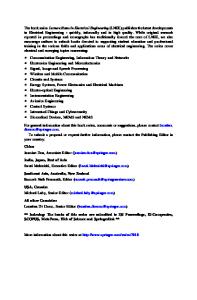Minimum-Fuel Formation Reconfiguration of Multiple Free-Flying Spacecraft
- PDF / 3,353,736 Bytes
- 26 Pages / 496.08 x 722.88 pts Page_size
- 17 Downloads / 319 Views
Minimum-Fuel Formation Reconfiguration of Multiple Free-Flying Spacecraft P. K. c. Wang l and F. Y. Hadaegh 2 Abstract The formation reconfiguration of multiple free-flying spacecraft is posed as an optimization problem involving minimum fuel expenditure. A method for obtaining simple solutions to this problem is proposed. The basic idea is to break up the formation reconfiguration process into a sequence of simple maneuvers involving a small number of spacecraft at a time. Moreover, the spacecraft move along straightline paths in the three-dimensional space. Thus, the minimum-fuel reconfiguration problem can be reduced to an optimization problem involving permutation groups. The proposed approach requires seeking fuel minimization over the set of all spacecraft permutation cycles of lengths ~2. Examples are given to illustrate the application of the proposed method.
Introduction Recently, the use of multiple spacecraft for long base-line interferometers, magnetosphere studies, and space-based communication networks was considered. Multiple-spacecraft interferometry was first proposed by Stachnik and his coworkers [1,2]. Its feasibility for LEO (Low-Earth-Orbit) was studied by DeCue [3] with emphasis on using thrust-free orbits to reduce the amount of necessary control effort for formation keeping. A description of the recently proposed New Millennium separated spacecraft interferometer was given in [4]. Subsequently, various problems associated with the coordination and control of formation flying of multiple spacecraft were studied. Wang and Hadaegh [5, 6] derived various control laws for the coordination and control of free-flying and LEO multiple spacecraft moving in formation using a Lyapunov approach. No optimization criteria were considered. A collection of papers and presentations on formation flying up to 1996 was compiled 'Professor, Department of Electrical Engineering, University of California, Los Angeles, CA 900951594. 2Senior Research Scientist and Technical Supervisor, Guidance and Control Analysis, Jet Propulsion Laboratory, California Institute of Technology, Pasadena, CA 91109-8099.
77
78
Wang and Hadaegh
by Lau [7]. Recently, various key issues associated with formation flying were identified in a workshop on formation flying and micro-propulsion [8]. It is obvious that efficient use of fuel is one of the main issues in any spacecraft maneuvers. In physical situations, failure in one or more spacecraft may occur; thus it is necessary to consider different options in maintaining the spacecraft formation without impairing its mission. The failure may take on various forms. When the failure is sufficiently severe such that the spacecraft is no longer useful, removal of the spacecraft from the formation is necessary. A possible option is to reconfigure the formation. Also, a change of mission objectives during flight may require formation reconfiguration. For example, in the case of an interferometer, formation reconfiguration may be required to suit a new target. Since the spacecraft have lim
Data Loading...











